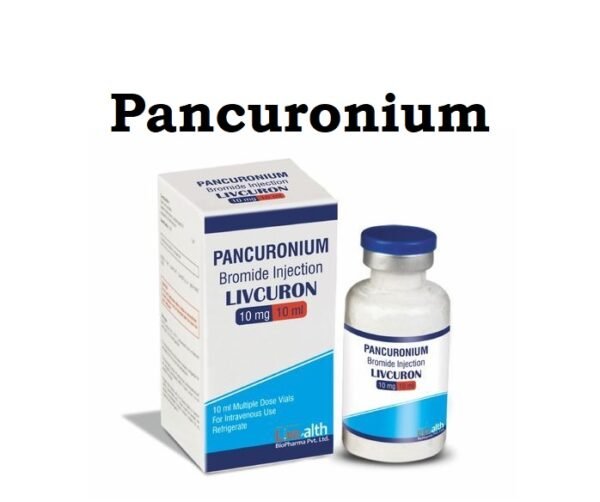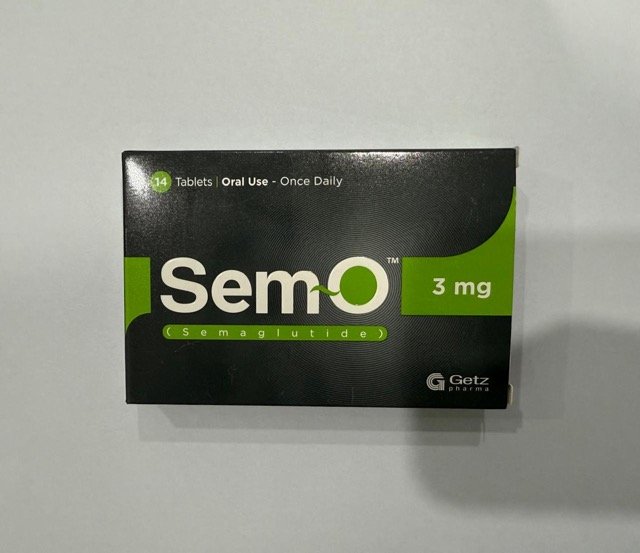Pancuronium (Pavulon) is a non-depolarizing neuromuscular blocking agent that is used to facilitate endotracheal intubation and mechanical ventilation.
Pancuronium Uses:
-
Neuromuscular blockade for endotracheal intubation, surgery, or mechanical ventilation:
- As an adjunct to general anesthesia to facilitate endotracheal intubation and for skeletal muscles relaxation during surgery or mechanical ventilation in adequately sedated ICU patients
Note:
- The neuromuscular blockade does not provide help in pain control, sedation, or amnestic effects.
- Appropriate analgesic and sedative medications should be used prior to and during the administration of neuromuscular blockade to develop deep sedation.
-
Off Label Use of Pancuronium in Adults:
- Acute respiratory distress syndrome;
- Shivering due to therapeutic hypothermia following cardiac arrest
Pancuronium Dose in Adults
Note:
- Dose to effect; doses varies due to interpatient variability.
- Ensure adequate pain control and sedation before and during the administration of neuromuscular blockade to produce deep sedation.
Pancuronium Dose in the treatment of Neuromuscular blockade for endotracheal intubation, surgery, or mechanical ventilation ( as an adjunct to general anesthesia):
- IV:
- Initial: 0.04 to 0.1 mg/kg or 0.05 mg/kg following initial dose of succinylcholine for intubation.
- maintenance dose: 0.01 mg/kg administered 60 to 100 minutes following the initial dose and then 0.01 mg/kg every 25 to 60 minutes
-
Pretreatment/priming:
- 10% of the intubating dose given 3 to 5 minutes prior to total intubating dose.
Pancuronium Dose to facilitate mechanical ventilation or for shivering from therapeutic hypothermia in the Intensive care unit:
-
- IV: 0.06 to 0.1 mg/kg bolus followed by 1 to 2 mcg/kg/minute (0.06 to 0.12 mg/kg/hour) or 0.8 to 1.7 mcg/kg/minute (0.048 to 0.102 mg/kg/hour)
Pancuronium Dose in Children
- Note: Dosing in obese patients should be calculated using ideal body weight.
Pancuronium Dose in the treatment of Paralysis and as a skeletal muscle relaxation:
-
Infants:
- Intermittent IV: 0.05 to 0.1 mg/kg/dose as needed (usually every 4 to 6 hours)
- Continuous IV infusion: 0.4 to 0.6 mcg/kg/minute (0.02 to 0.04 mg/kg/hour)
-
Children:
- Intermittent IV: 0.05 to 0.15 mg/kg/dose as needed (usually every 4 to 6 hours).
- Continuous IV infusion: 0.5 to 1 mcg/kg/minute (0.03 to 0.06 mg/kg/hour).
-
Adolescents:
- Intermittent IV: 0.05 to 0.15 mg/kg/dose as needed (usually every 4 to 6 hours).
- Continuous IV infusion: 0.4 to 0.6 mcg/kg/minute (0.02 to 0.04 mg/kg/hour).
Pregnancy Risk Factor C
- Studies on animal reproduction have not been done.
- The placenta can be crossed by small amounts of pancuronium.
- It can be used for short-term cesarean sections; patients who also receive magnesium sulfate should take a lower dose due to its enhanced effects.
Pancuronium Dose in Kidney Disease:
- The elimination half-life is increased by twofold, plasma clearance is decreased and recovery rates are sometimes slower.
-
The manufacturer's labeling does not include any dosage adjustments. However, the following modifications have been suggested:
-
CrCl >50 mL/minute:
- No dosage adjustment is necessary.
-
CrCl 10-50 mL/minute:
- Administer 50% of normal dose
-
CrCl <10 mL/minute:
- Avoid use.
-
Hemodialysis/peritoneal dialysis:
- Avoid use.
-
CRRT:
- Administer 50% of the normal dose.
-
Pancuronium Dose in Liver Disease:
- The elimination half-life is increased by two
- Plasma clearance has been doubled
- Recovery time can take a while.
- Volume of distribution is increased by 50%, which results in a slower start, higher total dose, and prolonged neuromuscular blockade.
- Patients suffering from liver disease could develop slow resistance to the nondepolarizing, muscle relaxants.
- Antagonism can occur when large doses are required.
Side effects of Pancuronium:
-
Cardiovascular:
- Flushing
- increased Blood Pressure
- increased Cardiac Work
- increased Pulse
- severe Myasthenia (Long-Term Use)
-
Central nervous system:
- Paralysis (long-term use)
-
Dermatologic:
- Skin rash (transient)
-
Gastrointestinal:
- Sialorrhea
Contraindications to Pancuronium:
- Hypersensitivity to bromide, pancuronium or any other component of the formulation
- There is not much evidence of allergenic cross-reactivity with neuromuscular blocking drugs.
- Cross-sensitivity can be possible due to similarities in chemical structure or pharmacologic effects.
Warnings and precautions
-
Anaphylaxis
- There have been cases of severe anaphylactic reactions (some even fatal). When using epinephrine 1, mg/mL, emergency treatment should be available immediately.
- Patients who have had anaphylactic reactions to neuromuscular blocking drugs in the past should be cautious
-
Burn injury
- Patients with burn injuries (>=20% total body surface area) may experience resistance. This can occur within days or weeks of the injury and may continue for many months (Han 2009).
-
Conditions that could lead to neuromuscular blockade (decreased parity)
- Antagonism of neuromuscular blockade may be caused by hypercalcemia, respiratory alkalosis and peripheral neuropathies.
-
Conditions that can increase paralysis (neuromuscular blockade):
- Potentially causing neuromuscular blockade may be electrolyte abnormalities, such as severe hypocalcemia, severe hyperkalemia, and hypermagnesemia.
-
Hepatic impairment
- Due to the reduced clearance of pancuronium, elimination half-life is twice as long and recovery takes longer.
- Patients with hepatic impairment should be cautious and adjusted the dose accordingly.
-
Renal impairment
- Due to decreased clearance of pancuronium, the elimination half-life is twice as long. Recovery is also prolonged. Patients with renal impairment should be cautious and adjust their dose accordingly.
Pancuronium: Drug Interaction
Note: Drug Interaction Categories:
- Risk Factor C: Monitor When Using Combination
- Risk Factor D: Consider Treatment Modification
- Risk Factor X: Avoid Concomitant Use
Risk Factor C (Monitor therapy) |
|
| Acetylcholinesterase Inhibitors | May diminish the neuromuscular-blocking effect of Neuromuscular-Blocking Agents (Nondepolarizing). |
| Aminoglycosides | May enhance the respiratory depressant effect of Neuromuscular-Blocking Agents. |
| Bacitracin (Systemic) | May enhance the neuromuscular-blocking effect of NeuromuscularBlocking Agents. |
| Botulinum Toxin-Containing Products | May enhance the neuromuscular-blocking effect of Neuromuscular-Blocking Agents. |
| Bromperidol | May enhance the neuromuscular-blocking effect of Neuromuscular-Blocking Agents. |
| Calcium Channel Blockers | May enhance the neuromuscular-blocking effect of Neuromuscular Blocking Agents (Nondepolarizing). |
| Capreomycin | May enhance the neuromuscular-blocking effect of Neuromuscular-Blocking Agents. |
| CarBAMazepine | May decrease the serum concentration of Neuromuscular-Blocking Agents (Nondepolarizing). |
| Cardiac Glycosides | Neuromuscular-Blocking Agents may enhance the arrhythmogenic effect of Cardiac Glycosides. |
| Clindamycin (Topical) | May enhance the neuromuscular-blocking effect of NeuromuscularBlocking Agents. |
| CycloSPORINE (Systemic) | May enhance the neuromuscular-blocking effect of NeuromuscularBlocking Agents. |
| Fosphenytoin-Phenytoin | May diminish the neuromuscular-blocking effect of NeuromuscularBlocking Agents (Nondepolarizing). Fosphenytoin-Phenytoin may enhance the neuromuscularblocking effect of Neuromuscular-Blocking Agents (Nondepolarizing). Fosphenytoin-Phenytoin may decrease the serum concentration of Neuromuscular-Blocking Agents (Nondepolarizing). |
| Inhalational Anesthetics | May enhance the neuromuscular-blocking effect of NeuromuscularBlocking Agents (Nondepolarizing). |
| Ketorolac (Nasal) | May enhance the adverse/toxic effect of Neuromuscular-Blocking Agents (Nondepolarizing). Specifically, episodes of apnea have been reported in patients using this combination. |
| Ketorolac (Systemic) | May enhance the adverse/toxic effect of Neuromuscular-Blocking Agents (Nondepolarizing). Specifically, episodes of apnea have been reported in patients using this combination. |
| Lincosamide Antibiotics | May enhance the neuromuscular-blocking effect of NeuromuscularBlocking Agents. |
| Lithium | May enhance the neuromuscular-blocking effect of Neuromuscular-Blocking Agents. |
| Local Anesthetics | May enhance the neuromuscular-blocking effect of Neuromuscular-Blocking Agents. Exceptions: Benzocaine; Benzydamine; Cocaine (Topical); Dibucaine; Dyclonine; Ethyl Chloride; Hexylresorcinol; Lidocaine (Ophthalmic); Lidocaine (Topical); Pramoxine; Proparacaine; Tetracaine (Ophthalmic); Tetracaine (Topical). |
| Loop Diuretics | May diminish the neuromuscular-blocking effect of Neuromuscular-Blocking Agents. Loop Diuretics may enhance the neuromuscular-blocking effect of NeuromuscularBlocking Agents. |
| Magnesium Salts | May enhance the neuromuscular-blocking effect of Neuromuscular-Blocking Agents. |
| Minocycline | May enhance the neuromuscular-blocking effect of Neuromuscular-Blocking Agents. |
| Pholcodine | May enhance the adverse/toxic effect of Neuromuscular-Blocking Agents. Specifically, anaphylaxis has been reported. |
| Procainamide | May enhance the neuromuscular-blocking effect of Neuromuscular-Blocking Agents. |
| QuiNIDine | May enhance the neuromuscular-blocking effect of Neuromuscular-Blocking Agents. |
| Spironolactone | May enhance the neuromuscular-blocking effect of Neuromuscular-Blocking Agents (Nondepolarizing). |
| Tetracyclines | May enhance the neuromuscular-blocking effect of Neuromuscular-Blocking Agents. |
| Thiazide and Thiazide-Like Diuretics | May enhance the neuromuscular-blocking effect of Neuromuscular-Blocking Agents (Nondepolarizing). |
| Trimebutine | May enhance the neuromuscular-blocking effect of Neuromuscular-Blocking Agents (Nondepolarizing). |
| Vancomycin | May enhance the neuromuscular-blocking effect of Neuromuscular-Blocking Agents. |
Risk Factor D (Consider therapy modification) |
|
| Colistimethate | May enhance the neuromuscular-blocking effect of Neuromuscular-Blocking Agents. |
| Corticosteroids (Systemic) | Neuromuscular-Blocking Agents (Nondepolarizing) may enhance the adverse neuromuscular effect of Corticosteroids (Systemic). Increased muscle weakness, possibly progressing to polyneuropathies and myopathies, may occur. |
| Polymyxin B | May enhance the neuromuscular-blocking effect of Neuromuscular-Blocking Agents. |
| Theophylline Derivatives | May enhance the adverse/toxic effect of Pancuronium. Theophylline Derivatives may diminish the neuromuscular-blocking effect of Pancuronium. Management: Pancuronium dosage adjustment may be necessary to induce paralysis in patients receiving concomitant theophylline derivatives. Monitor closely for adverse effects (e.g., cardiac effects) with concomitant use of these agents. |
Risk Factor X (Avoid combination) |
|
| QuiNINE | May enhance the neuromuscular-blocking effect of Neuromuscular-Blocking Agents. |
Monitoring Parameters:
- Vital signs (heart rate and blood pressure, respiratory rate)
- Degree of muscle paralysis (eg., presence of spontaneous movements, ventilator synchroy, shivering) and you might consider using a peripheral nerve stimulator to monitor four points along with clinical assessments.
- If the level of blockade is properly monitored in the ICU, prolonged paralysis or generalized myopathy may be reduced.
How to administer Pancuronium?
- IV: May be administered undiluted by rapid IV injection.
Mechanism of action of Pancuronium:
- By binding to cholinergic receptors, it blocks neural transmission at myoneural junction
The Onset of effect :
- Infants: 2 to 5 minutes;
- Children: 2 to 4 minutes;
- Adults: 3 to 5 minutes
Duration (dose dependent):
- Children: 24 minutes;
- Adults: 22 minutes;
- hypothermia may prolong the duration of action.
Protein binding:
- 87%
Metabolism:
- Hepatic (30% to 45%); active metabolite 3-hydroxypancuronium ( / to / the activity of parent drug)
Half-life elimination:
- 89 to 161 minutes
Excretion: Urine (40%); bile (11%)
International Brands of Pancuronium:
- GEN-Pancuronium
- Alpax
- Bemicin
- Bromurex
- Curon-B
- Laxacurium
- Maoblock
- Neocuron
- Panalon
- Panconium
- Pancuron
- Pancuronio
- Pancuronium
- Pancuronium Bromide
- Pavulon
- Unacron
Pancuronium Brand Names in Pakistan:
Pancuronium bromide Injection 4 mg |
|
| Waycron | Caraway Pharmaceuticals |
Pancuronium Bromide Injection 2 mg/ml |
|
| Pancron | Brookes Pharmaceutical Laboratories (Pak.) Ltd. |
| Pancur | Akhai Pharmaceuticals. |
| Pancuronium | Haji Medicine Co. |
| Parium | Saydon Pharmaceutical Industries (Pvt) Ltd. |
| Pavulon | Obs |



.jpeg)



